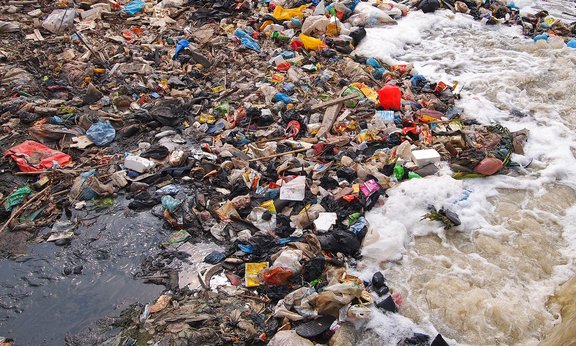“The world is facing a global resource crisis,” says Martin Stuchtey. Every year eight to twelve tons of plastic are added to the huge amount already drifting in the ocean. “If you compare these numbers to the total amount of edible fish in the ocean, we observe a frightening ratio: Today for every three kilograms of fish there is one kilogram of plastic in the ocean. Until 2050 we expect the ratio to decrease to one kilogram of fish to one kilogram of plastic,” explains the academic. Only two percent of the plastic materials are washed ashore or are visible at the water surface. The bigger amount has already been broken up into minuscule particles by UV light and waves. “Fish ingest the plastic particles with their food. There are already signs of massive impacts on the metabolism of marine organisms that are or will be our future protein sources,” warns Stuchtey. So far nobody has any answers for this huge problem as the whole plastics industry is not geared towards preventing the waste material. More than half of the plastic leakage into the ocean is caused by countries such as Indonesia, the Philippines and China, where the amount of packaging material has increased dramatically. Contrary to Europe, these countries haven’t established sufficient disposal or recycling systems yet.
Rethinking plastics
High-quality, useful, hygienic and affordable: today plastic is one of the most important materials in the world. “Unfortunately, only two percent of plastic produced worldwide is reclaimed from old plastics. Over 30 percent of plastic packaging leaks into the ecosystems,” says Stuchtey and he underlines: “To be honest, this is a global failure. Not only because our planet is at its limit, which has already become visible and noticeable. We are acting in an economically unsound way when we do not recycle or re-use 98 percent of the 311 million tons of new produced plastic materials annually.” Apart from efforts to produce plastics from renewable resources, the experts’ big goal is to establish a Global Plastics Protocol. It is to bring industry stakeholders together to agree on which type of plastic may be used so that in the future 70 to 80 percent of all plastic packaging will be made out of a small defined number of materials. Similar to PET bottles, it should be possible to identify every type of packaging after its first life cycle and recycle it profitably. Following the principles of circular economy, the economist recommends creating incentives for the industry to close the life cycle of materials. For example, the manufacturers could be forced to take all their products back after their use: “When manufacturers produce plastics with prohibited substances, they will become their problem later on because they will be responsible for their disposal. This will lead the manufacturers to consider their products’ post-use from the beginning to ensure that the company will not have to deal with any problems involved.” To achieve this, we not only need innovative material design and modern recycling technologies but also new business models. “This is a huge playing field for environmental entrepreneurs,” underlines Stuchtey.
Not wasting
The main goal is to optimize the handling of plastics and not to completely remove them from the market. “Plastic is an excellent material, which guarantees us immense prosperity. We cannot do without it in sanitation or with regard to food shelf life. However, it cannot be part of a single-use system but has to be designed for re-use,” says the academic. The annual use of 80 to 90 kilograms of plastics per capita in Europe ranks significantly below the average for countries such as Taiwan or the USA, where currently 120 kilograms of plastics per capita are used. “But successfully reducing those numbers by half is not the sole solution to the problem,” explains Stuchtey. Western countries in particular are encouraged to come up with radical ideas and solutions. Doing without plastic shopping bags is a good start, which may contribute to a rethinking of the status quo in society. “It is unacceptable that a fundamentally sound material doesn’t have any economic value at the end of its use but creates social costs. For example, the majority of malaria cases or other infectious diseases in Africa and Asia are caused by mosquitos living in plastic waste accumulated in water puddles. In addition, it is a huge problem to lose marine bio productivity through oceanic littering and pollution,” says Stuchtey. The terms that will allow us to keep producing and using plastic require keeping these ramifications in mind and looking for a sustainable solution. Within the framework of his position at the University of Innsbruck, Martin Stuchtey wants to contribute to sustainable resource management.
Sustainable Resource Management
Prof. Dr. Martin Stuchtey, Prof. Gabriele Chiogna and Prof. Kerstin Neumann are part of the Innovation Lab for Sustainability at the University of Innsbruck. This institute has two endowed chairs established by the endowment fund SUN Institute Environment and Sustainability. SUN supports institutions, programs and projects dealing with the environmental challenges and opportunities arising from globalization, enhanced cross-border activities and international cooperation. Each professor studies topics about sustainable resource management from the perspective of their respective field. The greater goal of the lab, however, is to integrate the topic of sustainability in an interdisciplinary way across the University of Innsbruck.

